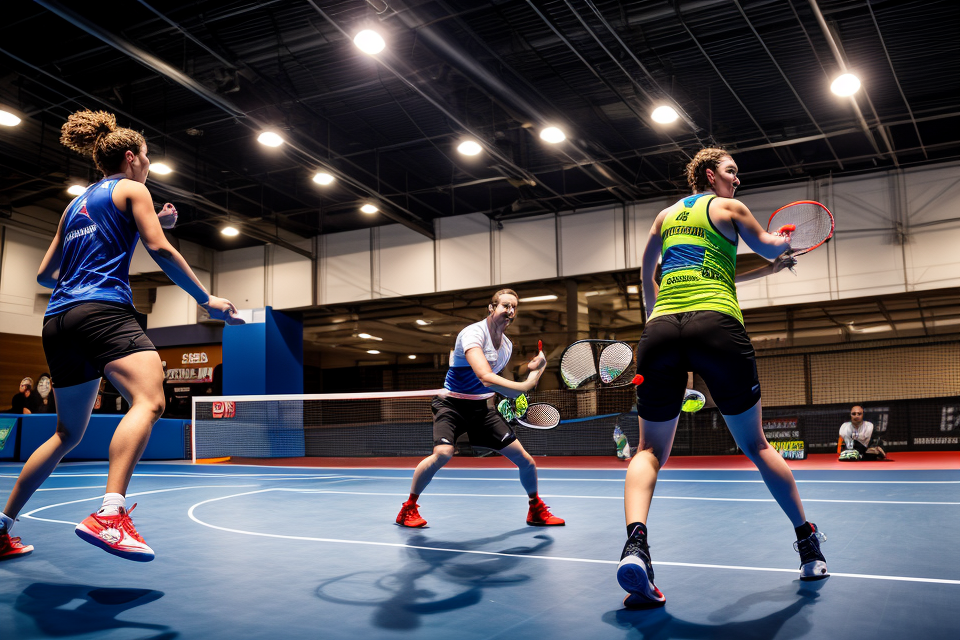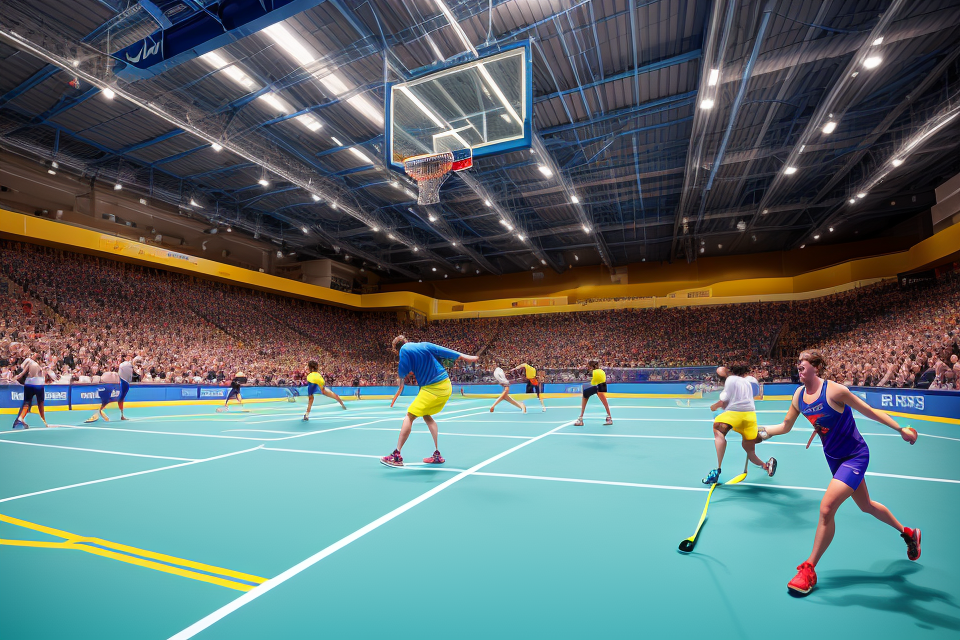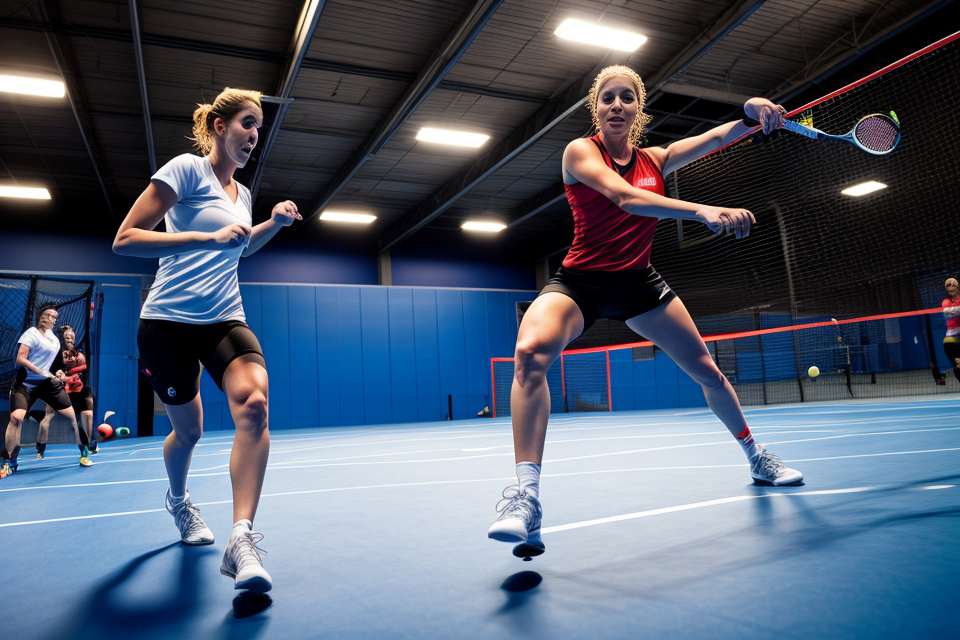Professional squash players are known for their agility, endurance, and precision on the court. To reach the top of their game, they undergo rigorous training regimens that combine physical conditioning, technical skills development, and mental toughness. This article will delve into the different aspects of squash training, from the types of exercises and drills used by players to the role of nutrition and mental preparation in achieving success on the court. Whether you’re a beginner or an experienced player, this insight into the world of professional squash training will give you a glimpse into the dedication and hard work required to reach the top of your game.
Professional squash players typically train for several hours a day, six days a week. Their training regimen often includes a combination of on-court drills, strength and conditioning exercises, and mental preparation. To improve their technical skills, players may hit thousands of balls against a wall or practice their strokes with a coach or training partner. They also work on their physical fitness to increase their endurance and speed on the court. Additionally, mental toughness and strategic thinking are crucial aspects of squash, so players often spend time analyzing their own game and their opponents’ styles to develop effective tactics. Overall, reaching the top of their game requires a combination of hard work, dedication, and a willingness to constantly learn and adapt.
Physical Conditioning
Cardiovascular Training
- Long-distance running: Squash players often incorporate long-distance running into their training regimen to improve their endurance and stamina on the court.
- High-intensity interval training: This type of training involves short bursts of intense exercise followed by periods of rest. It is an effective way for squash players to improve their cardiovascular fitness and overall conditioning.
- Rowing machines: Rowing is a non-impact exercise that can be gentle on joints while still providing a challenging workout. Professional squash players may use rowing machines to build their cardiovascular strength and improve their overall fitness.
Strength Training
- Resistance training: Squash players use resistance training to build muscle and improve their overall strength. This can include exercises such as weightlifting, resistance bands, and bodyweight exercises like push-ups and squats.
- Weightlifting: Weightlifting is a common form of strength training for professional squash players. It helps to build muscle, increase power, and improve overall physical fitness.
- Bodyweight exercises: Bodyweight exercises are a great way for squash players to build strength and improve their overall fitness without the need for expensive equipment. Exercises such as lunges, planks, and pull-ups can be done anywhere and are highly effective.
Flexibility and Mobility Training
- Stretching: Squash players often incorporate stretching into their training regimen to improve their flexibility and range of motion. This can help to prevent injuries and improve overall performance on the court.
- Yoga: Yoga is a great way for squash players to improve their flexibility, balance, and mental focus. It can also help to reduce stress and improve overall well-being.
- Pilates: Pilates is a form of exercise that focuses on core strength, flexibility, and body control. Professional squash players may incorporate Pilates into their training regimen to improve their overall physical fitness and reduce the risk of injury.
Technical Skills Training
Professional squash players undergo rigorous technical skills training to improve their footwork, agility, stroke development, and tactics and strategy. Here are some of the drills and techniques used by elite players to enhance their technical abilities:
Footwork and Agility
- Drills to improve footwork and agility: Professional squash players spend a significant amount of time practicing footwork drills to enhance their speed, agility, and footwork accuracy. Some of the most common footwork drills include ladder drills and shuffle drills. Ladder drills involve running up and down a ladder placed on the court, which helps players develop quick movements and improve their reaction times. Shuffle drills, on the other hand, involve moving sideways across the court, which helps players develop the necessary speed and agility to make quick directional changes.
- Ladder drills: Ladder drills are an essential part of technical skills training for squash players. They involve running up and down a ladder placed on the court, which helps players develop quick movements and improve their reaction times. Players typically start with simple ladder drills and gradually increase the complexity as they become more proficient.
- Shuffle drills: Shuffle drills involve moving sideways across the court, which helps players develop the necessary speed and agility to make quick directional changes. Players practice shuffling in different directions, including forwards, backwards, and sideways, to improve their footwork accuracy and speed.
Stroke Development
- Stroke analysis: Professional squash players often undergo stroke analysis to identify areas of improvement in their technique. A coach or a trained professional will analyze the player’s strokes, identify any weaknesses or flaws, and provide feedback on how to correct them.
- Repeat the stroke: To develop a consistent and accurate stroke, players practice repeating the same stroke repeatedly until it becomes second nature. This technique helps players develop muscle memory and improve their accuracy and consistency.
- Stroke combination drills: To develop a well-rounded stroke, players practice combination drills that involve multiple strokes in succession. For example, a player may practice a series of forehand drives followed by a backhand drop shot. This technique helps players develop their overall stroke development and improve their court awareness.
By focusing on technical skills training, professional squash players can develop the necessary physical and mental abilities to reach the top of their game.
Mental Game
Visualization
Visualization is a key component of the mental game for professional squash players. By imagining successful shots and match scenarios, players can build confidence and develop a sense of control over their performance. This technique can also help players to prepare for different scenarios that may arise during a match, such as being down in the score or facing a difficult opponent.
Moreover, visualization can also help players to develop mental toughness, which is crucial for success in squash. By visualizing themselves successfully overcoming challenges and adversity, players can build resilience and learn to stay focused and composed under pressure.
Mental Conditioning
In addition to visualization, mental conditioning is an important aspect of the mental game for professional squash players. This includes setting goals, developing focus and concentration, and learning how to handle pressure and adversity.
Setting specific, measurable, and achievable goals can help players to stay motivated and focused on their development. It is important for players to break down their goals into smaller, manageable steps, and to track their progress along the way.
Focus and concentration are also crucial for success in squash. Players must learn to tune out distractions and stay focused on the task at hand, whether they are on the court or preparing for a match. This requires a high level of mental discipline and self-awareness.
Finally, learning how to handle pressure and adversity is an essential aspect of mental conditioning for professional squash players. Players must learn to stay calm and composed under pressure, and to bounce back from setbacks and losses. This requires a positive mindset and a willingness to learn from mistakes and failures.
Nutrition and Recovery
Proper Nutrition
Proper nutrition is essential for professional squash players to maintain their energy levels, support muscle growth and repair, and support overall health and well-being. A balanced diet that includes a variety of fruits, vegetables, whole grains, lean proteins, and healthy fats is recommended. Adequate protein intake is also important to support muscle growth and repair. Hydration is also crucial to maintain energy levels and prevent dehydration during long matches.
Recovery Techniques
Recovery techniques are crucial for professional squash players to prevent injury and optimize performance. Rest and recovery time is essential to allow the body to repair and rebuild muscles. Massage therapy can help to reduce muscle soreness and improve circulation. Foam rolling is a self-massage technique that can help to release tension in the muscles and improve flexibility. Professional squash players may also use compression garments to support muscle recovery and reduce inflammation. It is important for players to work with a sports nutritionist or dietitian to develop a personalized nutrition and recovery plan that meets their individual needs and goals.
Squash-Specific Drills
Skill-Based Drills
Professional squash players often incorporate skill-based drills into their training regimen to improve their technical abilities on the court. These drills can be used to develop specific skills such as volleys, drives, and drop shots.
Volley Drills
Volley drills are an essential part of a squash player’s training as they involve hitting the ball in the air, which is a common occurrence in the sport. Some examples of volley drills include hitting the ball back and forth with a partner, practicing volleys with different types of shots, and incorporating movement and footwork into the drills.
Drive Drills
Drive drills are used to improve a player’s ability to hit the ball with power and accuracy. These drills may involve hitting the ball against a wall or practicing drives with a partner. Examples of drive drills include hitting the ball cross-court, hitting the ball down the line, and practicing drives with different types of shots.
Drop Shot Drills
Drop shot drills are used to improve a player’s ability to hit the ball with precision and control. These drills may involve hitting the ball softly against a wall or practicing drop shots with a partner. Examples of drop shot drills include hitting the ball short and soft, practicing drop shots with different types of shots, and incorporating movement and footwork into the drills.
Match Simulation Drills
Match simulation drills are used to prepare players for the physical and mental demands of competitive squash matches. These drills simulate match conditions and help players practice different court positions and tactics.
Drills to Simulate Match Conditions
Drills to simulate match conditions may involve playing points or sets against a partner or practicing different scenarios that may occur during a match. For example, a player may practice serving under pressure or practicing the shot clock. These drills help players get used to the time constraints and pressure of a real match.
Simulated Match Play
Simulated match play involves playing a series of points or games against a partner or opponent in a simulated match environment. This type of drill is used to help players prepare for the mental and physical demands of a real match. Simulated match play may involve practicing different tactics and strategies, as well as working on mental aspects such as focus and concentration.
Drills to Practice Different Court Positions and Tactics
Drills to practice different court positions and tactics may involve working on specific skills such as hitting to the back of the court or practicing different types of shots. These drills help players develop their court awareness and prepare for different scenarios that may occur during a match.
Squash-Specific Equipment
Professional squash players understand the importance of having the right equipment to help them perform at their best. Squash-specific equipment is designed to enhance their performance and minimize the risk of injury.
Squash-Specific Shoes
Squash-specific shoes are lightweight and flexible, with non-marking soles that provide good grip on different court surfaces. These shoes are designed to give players the support they need to move quickly and change direction rapidly. The lightweight construction of these shoes allows players to move around the court with ease, while the flexible sole allows them to make quick cuts and turns.
Some of the top brands of squash-specific shoes include Adidas, Asics, and New Balance. These shoes are designed to meet the specific needs of squash players, with features such as non-slip soles, good traction, and excellent support.
Squash-Specific Clothing
Squash-specific clothing is designed to be breathable, moisture-wicking, and lightweight. This type of clothing is designed to allow players to move freely and comfortably, while also providing them with the support they need to perform at their best.
Breathable fabric is essential for squash players, as it helps to keep them cool and comfortable during intense matches. Moisture-wicking fabric draws sweat away from the body, keeping players dry and comfortable. Lightweight clothing is also important, as it allows players to move quickly and easily around the court.
Comfortable fit is also crucial for squash players, as it allows them to move freely and comfortably. Squash-specific clothing is designed to provide a comfortable fit for a range of motion, allowing players to make quick and powerful movements without feeling restricted.
Squash-Specific Accessories
Squash-specific accessories are designed to help players perform at their best and minimize the risk of injury. Some of the most popular accessories include wristbands, grip enhancers, and sunglasses with non-reflective lenses.
Wristbands are designed to provide support and stability to the wrists, which are important for maintaining good form and reducing the risk of injury. Grip enhancers are designed to help players maintain a firm grip on their racquet, even in sweaty conditions. Sunglasses with non-reflective lenses are essential for squash players, as they help to reduce glare and improve visibility on the court.
Overall, squash-specific equipment is an essential part of a professional squash player’s training regimen. By using the right equipment, players can enhance their performance, minimize the risk of injury, and stay comfortable and focused during intense matches.
Professional Squash Player Training Programs
Personalized Training Programs
- One-on-one coaching: Professional squash players often work with personal coaches who provide individualized training programs tailored to their specific needs and goals. These coaches may be former professional players themselves, or experienced coaches who specialize in squash training.
- Customized training plans: Each player’s training plan is unique and is based on their strengths, weaknesses, and goals. The plan may include a combination of physical conditioning, technical drills, match simulation, and mental preparation.
- Regular progress monitoring: To ensure that the training program is effective, players are regularly assessed and their progress is monitored. This allows coaches to make adjustments to the training program as needed to help the player reach their goals.
Group Training Programs
- Group classes: Many professional squash players participate in group training sessions, which provide an opportunity to practice and improve their skills in a group setting. These classes may be led by a coach or may be more informal, with players working together to practice their skills.
- Team training: Some professional squash players may also participate in team training, which involves working together with other players to achieve a common goal. This type of training can help players develop teamwork skills and learn how to work together to achieve success.
- Training camps: In addition to regular training sessions, many professional squash players also attend training camps, which are intensive training sessions that take place over several days or weeks. These camps may be held at a dedicated training facility or may take place at a sports complex.
Online Training Programs
- Virtual coaching: With the advent of technology, it is now possible for professional squash players to receive coaching from coaches located remotely. This can be done through video conferencing or online coaching platforms, which allow players to receive personalized coaching and feedback from coaches who are not physically present.
- Video analysis: Many professional squash players use video analysis to review their performances and identify areas for improvement. This can be done through specialized software or by reviewing recordings of matches or training sessions.
- Remote coaching: Some professional squash players also work with coaches remotely, through phone or video calls. This allows players to receive coaching from coaches who may not be located near them, or who may not be available for in-person coaching sessions.
Squash Player Training Challenges
Injury Prevention
Injury prevention is a critical aspect of squash player training. Professional squash players face a high risk of injury due to the intense physical demands of the sport. To prevent injuries, players must prioritize proper warm-up and cool-down exercises. This includes dynamic stretching, foam rolling, and mobility exercises to prepare the body for intense physical activity. Additionally, players should incorporate injury prevention exercises into their training regimen, such as strength training and plyometrics. Listening to the body and taking rest days when needed is also essential to prevent overuse injuries.
Time Management
Time management is another challenge that professional squash players face when training to reach the top of their game. Balancing training with work and family commitments can be challenging, and players must prioritize their training and recovery time effectively. Effective time management strategies, such as creating a training schedule and setting goals, can help players make the most of their training time. Players may also need to travel to training facilities, which can be time-consuming and require effective planning. Some players may even create a home training setup to save time and money.
Squash Player Training Myths
“More is Better” Mentality
When it comes to training for squash, many players fall into the trap of thinking that more is better. They may push themselves to the limit every day, thinking that this will help them improve their game. However, this approach can lead to overtraining and burnout, which can have a negative impact on their performance.
Instead, professional squash players focus on quality over quantity. They understand that it’s essential to give their bodies enough rest and recovery time to avoid injury and maximize their performance on the court. This means that they may not train every day, but when they do, they give it their all and make the most of their time on the court.
“Natural Talent” Myth
Another common myth about squash training is that natural talent is the key to success. While it’s true that some players may have a natural ability that gives them an advantage, the reality is that hard work and dedication are just as important.
Professional squash players understand that success on the court is the result of years of hard work and dedication. They work tirelessly to improve their weaknesses and continuously learn and develop their skills. They know that it takes a lot of effort to reach the top of their game, and they’re willing to put in the work to get there.
“One-Size-Fits-All” Approach
Finally, many players make the mistake of thinking that there’s a one-size-fits-all approach to squash training. They may follow a training plan that worked for someone else, without taking into account their own unique needs and goals.
However, professional squash players understand that everyone is different, and that’s why they work with a coach to create a customized training plan that meets their specific needs. They also regularly monitor their progress to ensure that they’re on track to achieve their goals.
In addition, professional squash players understand the importance of periodization and variation in their training. They know that it’s essential to mix things up and try new things to avoid hitting a plateau and to keep their bodies challenged. By avoiding the “one-size-fits-all” approach, they’re able to get the most out of their training and achieve their full potential on the court.
Squash Player Training Resources
Squash-Specific Books
Squash players looking to improve their game can turn to a variety of squash-specific books for guidance. These books offer a wealth of information on training techniques, drills, and conditioning exercises specifically tailored to the sport of squash. Some of the most highly recommended books include:
- Squash Drills by John White: This book provides a comprehensive guide to squash drills, covering everything from basic skills to advanced techniques. It also includes tips on how to design effective training programs and incorporate drills into match preparation.
- Squash Fitness by Graeme Windrum: This book focuses on the physical aspects of squash training, including strength and conditioning exercises, flexibility routines, and injury prevention techniques. It also offers advice on nutrition and hydration for optimal performance on the court.
- Squash Training by Mark Fenwick: This book covers all aspects of squash training, from the basics of the sport to advanced strategies and tactics. It includes a range of drills and exercises for improving shot selection, movement, and endurance, as well as mental toughness and match play.
Squash-Specific Websites
In addition to books, there are several squash-specific websites that offer valuable training resources for players of all levels. These websites provide access to training videos, articles, and tips from top coaches and players in the sport. Some of the most popular websites include:
- SquashSource.com: This website offers a wide range of squash-related content, including training videos, drills, and articles on technique, strategy, and fitness. It also features interviews with top players and coaches, as well as coverage of major tournaments and events.
- SquashMagazine.com: This website is dedicated to squash news, player profiles, and training resources. It includes articles on technique, fitness, and mental toughness, as well as video lessons and interviews with top players and coaches.
- SquashSkills.com: This website provides a comprehensive guide to squash skills and tactics, including videos, articles, and training tips. It covers everything from basic shot techniques to advanced strategies and tactics, as well as fitness and conditioning exercises.
Squash-Specific Coaches and Trainers
For players looking for more personalized training, hiring a coach or trainer can be a valuable investment. There are many experienced coaches and trainers available who specialize in squash training, offering one-on-one instruction, group classes, and customized training programs. Some players also turn to online coaching and resources, which can provide access to expert advice and guidance from anywhere in the world. Finally, many players also join training programs or camps, which offer intensive coaching and training in a group setting. These programs can be a great way to improve skills and conditioning in a short period of time, as well as network with other players and coaches in the sport.
FAQs
1. How many hours do professional squash players train per day?
Professional squash players typically train for several hours a day, with some players training up to 6 hours a day. The training schedule can vary depending on the player’s individual needs and goals, but most players aim to train at least 5 days a week.
2. What types of training do professional squash players do?
Professional squash players engage in a variety of training activities to improve their physical and mental skills. This can include cardiovascular training, strength and conditioning exercises, technical drills, match simulation drills, and mental conditioning exercises. Many players also work with coaches and sports psychologists to develop their overall game.
3. How important is physical fitness for squash players?
Physical fitness is crucial for squash players, as the sport requires excellent endurance, strength, and agility. Players typically focus on building their cardiovascular endurance, muscular strength and endurance, and flexibility through a combination of cardio and strength training exercises.
4. How do squash players improve their technical skills?
Squash players work on their technical skills through a variety of drills and exercises. This can include hitting against a wall or a partner, practicing their volleys and drop shots, and working on their footwork and movement on the court. Players may also work with coaches to analyze their technique and identify areas for improvement.
5. How do squash players prepare for a match?
Before a match, squash players typically warm up by hitting some balls and doing light stretching. They may also review their opponent’s playing style and game plan their strategy for the match. During the match, players will need to stay hydrated and focus on their technique and mental game to perform at their best.










